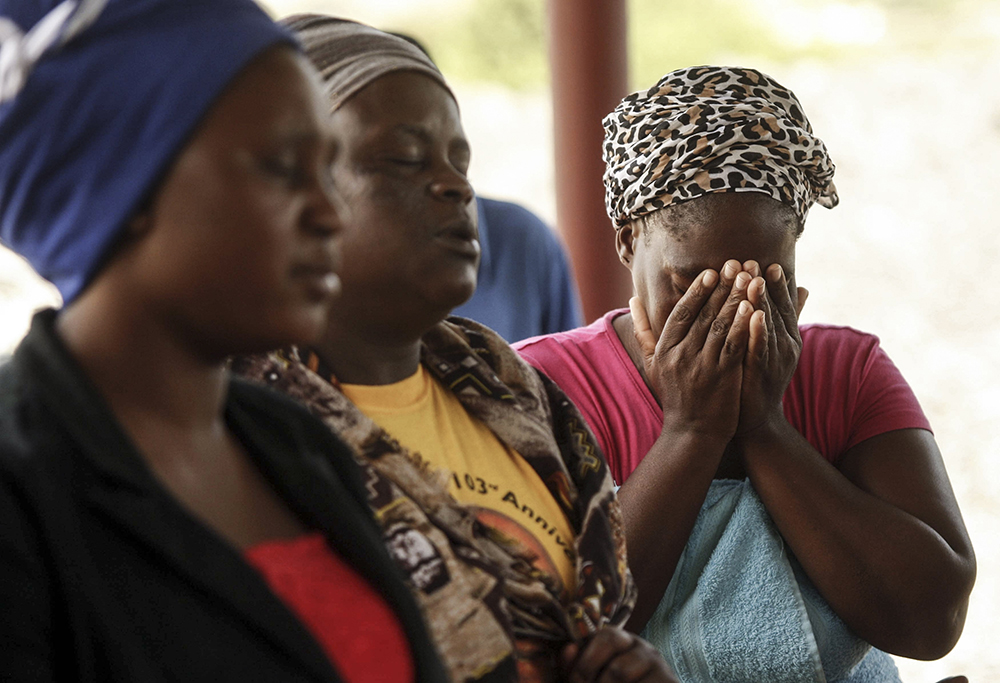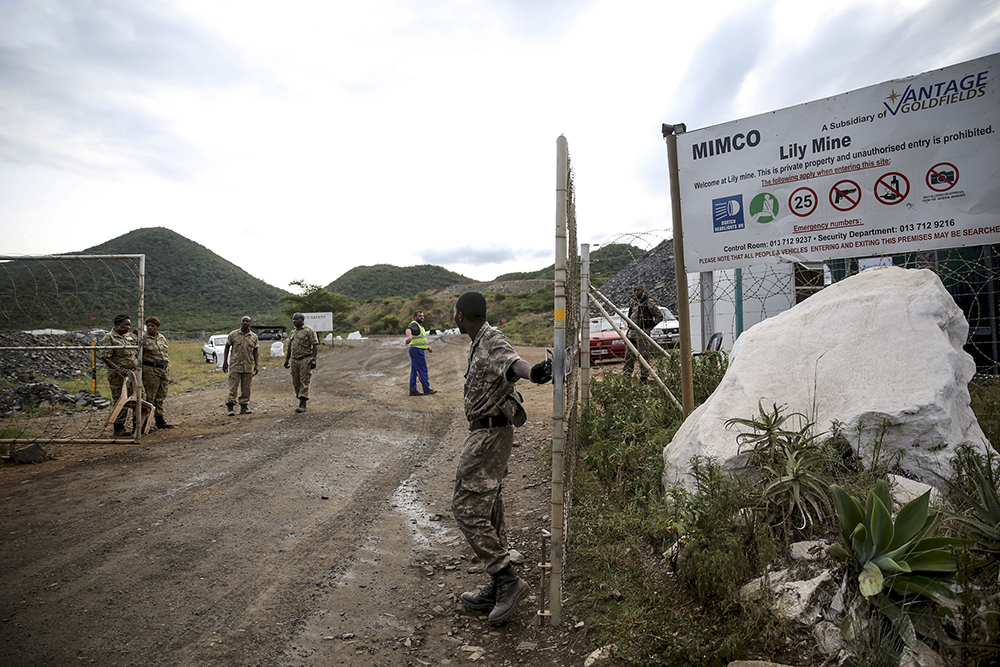Rescuers have been toiling around the clock
Tap … tap tap … tap tap tap. Members of the Mine Rescue Services team hit a steel pipe on a rock, sending an audio signal to a metal container 80m below the surface at Vantage Goldfields’s Lily Mine in Mpumalanga. Tap … tap tap … tap tap tap. An identical signal returns from inside the container, the first sign of life since Pretty Nkambule, Solomon Nyerende and Yvonne Mnisi were trapped last Friday.
It’s early Monday morning, about 65 hours since a pillar supporting a declining pathway towards the tunnels of the opencast mine collapsed. The sign of life from inside what used to be a lamp room rejuvenates rescue efforts and brings hope to the workers’ families, who have been allocated a room in which to sleep and pray in one of the offices near the site.
“As a pastor myself and an employee at this mine, I feel it is my responsibility to make sure the families don’t give up hope,” says Elmond Mnisi, the father of one of the two women in the container.
“We pray together for the safety of our children and the operations of the rescue team while sitting inside that room. We’ve been treated very well by the company. I asked God to intervene and grant us a miracle.”
For the rescue teams, the signs of life confirm they’re on the right path. They’ve been working in shifts without stopping since the operation began.
Says the mine’s operational manager, Mike Begg: “It’s amazing. We’ve been working for such a long time and, naturally, frustration begins to set in. Then suddenly, you hear those sounds from inside the container and everyone’s adrenaline starts pumping again. It’s breathed new life into the mission.”
His sentiments are echoed by Joseph Mathunjwa, the leader of the Association of Mineworkers and Construction Union (Amcu), as well as by the office of the president, who asks South Africans to keep the rescue teams in their prayers.
But outside the mine community, members and friends of the workers become less hopeful. Church services are held at the entrance of the mine every night. After three days of searching, Pretty Nkambule’s brother-in-law, Titus Nkosi, says he feels defeated. “The way that the management has described the accident seems like a disaster. We trust God but we doubt they are still alive.”
News of the signs of life from inside the container attract more people to the mine. Neighbours, friends and colleagues camp out near the mine entrance, hoping for another audio signal to keep hope alive.
Among them is Sibongile Nkosi, who lives next door to Solomon Nyerende in the “Doekies” mining village, about 30 minutes from the Lily Mine. “Hearing that Solomon has made contact with the rescue teams is an answer to my prayers. May God keep them alive. We trust he will emerge alive,” she says.
The intermittent tapping from inside the container continues throughout the day and begins to fade as night falls. This sparks concern among members of the rescue team, who fear that time is running out for the three workers. They entered the lamp room with only their lunches for the Friday shift and, three days later, their food and water is running out.
The concern is visible on the face of Elmond Mnisi. “Even if my family is torn apart because of this, I’m okay. I’m keeping it together,” he says.

Relatives of the three trapped mineworkers pray for a miracle. (Vathiswa Ruselo, Gallo)
When the collapse happened, more than 20 000 tonnes of rock and debris crashed down into the 80m hole, burying the container along with ventilation pipes, fencing and other material. The rescue mission started at 8.30am on Friday, about an hour after the ground beneath the 30m-long metal container used as a lamp room began to cave in.
Seventy-nine underground workers were the first to resurface from a ventilation pipe, unharmed and seemingly unaware of the tragedy they had narrowly avoided. Six other workers followed, climbing 250m up nearly vertical steps.
“The team leader told us we had to leave the shaft because there was an emergency. We didn’t know what happened, even though we had come down the shaft about 15 minutes earlier. When I got to the surface I was shocked … I’m praying for my colleagues,” says one of the workers who escaped any harm.
Lily Mine has 13 levels underground. The collapse has left the first four levels inaccessible and rescuers say the container is placed between the fourth and fifth levels.
After four days of searching, the team starts questioning whether they’ve focused their efforts in the correct area. Their decision is vindicated when an electromagnetic survey machine, usually used during the exploration phase of mining, arrives at the mine in the early hours of Tuesday morning after it was transported from Johannesburg, four hours away. The machine is lowered into the tunnels below the rockfall using hoists, and then used to pinpoint the exact location of the container.
The team’s progress is slow and, after receiving no sign of life for more than 12 hours, rescuers start fearing the worst. Morale saps away. Energies flag. Then: tap … tap … tap. The signal reaches the rescuers’ ears at about 4pm on Tuesday. Efforts are redoubled.
“There’s definitely someone in that container registering our signal. We think there was a period of silence because our employees are slipping in and out of consciousness. That’s not a bad sign, because a slower heartbeat means you breathe less oxygen and can survive for longer,” says Begg.

Security guards keep watch at the entrance of Lily Mine near Barberton as rescue efforts continue. (Siphiwe Sibeko, Reuters)
Tuesday’s audio signal is also a sigh of relief for the parents, who have been praying for a sign. Mnisi said: “I was encouraged by the news. It gave me a sense of renewed strength. The families that are here have experienced mixed emotions. Hearing about the signals helps keep everyone focused on praying for them.”
The 17-member team is using controlled explosions to crack and dismantle boulders blocking the pathway to the container. This can be a tedious process, because they’re faced with rocks that are up to 5m tall, stuck in a vertical position. First they drill into the rock and then insert a small amount of explosives, using mud packs, to crack it. When this is done, the rocks are dismantled and hoisted up the escape route.
This has become the only way to get into the mine, leaving the rescue crew vulnerable if the controlled blasts are mistimed or another collapse happens.
After spending nearly 12 hours underground with the rescue team, Amcu’s Mathunjwa describes the operation as “delicate”.
“The co-operation between the teams is fantastic. They are working well under the circumstances, but it takes long because you have to carefully blast the rocks and clear the debris. I must congratulate the operators of the machines, the crew, who have been able to do the job in a very tight space.”
Lily Mine has one of the best safety records for gold mines in the country and Begg describes the collapse as a “freak accident”.
By Thursday morning, there are very different scenes outside the mine. The rescue effort was briefly called off the previous night because of rain, which threatened the stability of the ground around the collapsed area. Another assessment of the ground was also conducted by the teams on site, to determine whether the supporting walls would collapse as a result of the amount of rock and debris being removed during the search.
A mineral resources department investigation into the collapse is also underway, adding to the pressure on the mine.
While officials at the mine reconsider their strategy, they remain silent about their plans, saying only that they need to prepare for any eventualities.
Hope seems to be fading among residents and relatives, who look to union officials for strength and encourage each other with song.
It’s been a week since the collapse occurred. And it’s been days since any signal, any tap tap tap, was heard from inside the metal container.
Meagre stock to sustain life
Inside the Lily Mine’s lamp room were 100 lights and safety packs, handed to each worker before they descend into the mine.
At the time of the collapse, mine authorities say the three workers had only their lunch packs for the day.
Rescue teams say they are not sure how the trio managed to survive for at least four full days, but remain hopeful that they were able to reach the safety packs, each of which contains 45 minutes of oxygen supply.